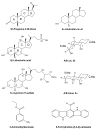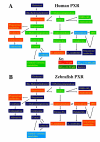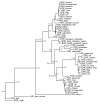Evolution of pharmacologic specificity in the pregnane X receptor
- PMID: 18384689
- PMCID: PMC2358886
- DOI: 10.1186/1471-2148-8-103
Evolution of pharmacologic specificity in the pregnane X receptor
Abstract
Background: The pregnane X receptor (PXR) shows the highest degree of cross-species sequence diversity of any of the vertebrate nuclear hormone receptors. In this study, we determined the pharmacophores for activation of human, mouse, rat, rabbit, chicken, and zebrafish PXRs, using a common set of sixteen ligands. In addition, we compared in detail the selectivity of human and zebrafish PXRs for steroidal compounds and xenobiotics. The ligand activation properties of the Western clawed frog (Xenopus tropicalis) PXR and that of a putative vitamin D receptor (VDR)/PXR cloned in this study from the chordate invertebrate sea squirt (Ciona intestinalis) were also investigated.
Results: Using a common set of ligands, human, mouse, and rat PXRs share structurally similar pharmacophores consisting of hydrophobic features and widely spaced excluded volumes indicative of large binding pockets. Zebrafish PXR has the most sterically constrained pharmacophore of the PXRs analyzed, suggesting a smaller ligand-binding pocket than the other PXRs. Chicken PXR possesses a symmetrical pharmacophore with four hydrophobes, a hydrogen bond acceptor, as well as excluded volumes. Comparison of human and zebrafish PXRs for a wide range of possible activators revealed that zebrafish PXR is activated by a subset of human PXR agonists. The Ciona VDR/PXR showed low sequence identity to vertebrate VDRs and PXRs in the ligand-binding domain and was preferentially activated by planar xenobiotics including 6-formylindolo-[3,2-b]carbazole. Lastly, the Western clawed frog (Xenopus tropicalis) PXR was insensitive to vitamins and steroidal compounds and was activated only by benzoates.
Conclusion: In contrast to other nuclear hormone receptors, PXRs show significant differences in ligand specificity across species. By pharmacophore analysis, certain PXRs share similar features such as human, mouse, and rat PXRs, suggesting overlap of function and perhaps common evolutionary forces. The Western clawed frog PXR, like that described for African clawed frog PXRs, has diverged considerably in ligand selectivity from fish, bird, and mammalian PXRs.
Figures





Similar articles
-
Functional evolution of the vitamin D and pregnane X receptors.BMC Evol Biol. 2007 Nov 12;7:222. doi: 10.1186/1471-2148-7-222. BMC Evol Biol. 2007. PMID: 17997857 Free PMC article.
-
The evolution of farnesoid X, vitamin D, and pregnane X receptors: insights from the green-spotted pufferfish (Tetraodon nigriviridis) and other non-mammalian species.BMC Biochem. 2011 Feb 3;12:5. doi: 10.1186/1471-2091-12-5. BMC Biochem. 2011. PMID: 21291553 Free PMC article.
-
Pregnane X receptor (PXR), constitutive androstane receptor (CAR), and benzoate X receptor (BXR) define three pharmacologically distinct classes of nuclear receptors.Mol Endocrinol. 2002 May;16(5):977-86. doi: 10.1210/mend.16.5.0828. Mol Endocrinol. 2002. PMID: 11981033
-
Functional evolution of the pregnane X receptor.Expert Opin Drug Metab Toxicol. 2006 Jun;2(3):381-97. doi: 10.1517/17425255.2.3.381. Expert Opin Drug Metab Toxicol. 2006. PMID: 16863441 Free PMC article. Review.
-
Evolution and function of the NR1I nuclear hormone receptor subfamily (VDR, PXR, and CAR) with respect to metabolism of xenobiotics and endogenous compounds.Curr Drug Metab. 2006 May;7(4):349-65. doi: 10.2174/138920006776873526. Curr Drug Metab. 2006. PMID: 16724925 Free PMC article. Review.
Cited by
-
The major human pregnane X receptor (PXR) splice variant, PXR.2, exhibits significantly diminished ligand-activated transcriptional regulation.Drug Metab Dispos. 2009 Jun;37(6):1295-304. doi: 10.1124/dmd.108.025213. Epub 2009 Feb 27. Drug Metab Dispos. 2009. PMID: 19251824 Free PMC article.
-
Vitamin K in Vertebrates' Reproduction: Further Puzzling Pieces of Evidence from Teleost Fish Species.Biomolecules. 2020 Sep 9;10(9):1303. doi: 10.3390/biom10091303. Biomolecules. 2020. PMID: 32917043 Free PMC article. Review.
-
The effect of the antidepressant venlafaxine on gene expression of biotransformation enzymes in zebrafish (Danio rerio) embryos.Environ Sci Pollut Res Int. 2020 Jan;27(2):1686-1696. doi: 10.1007/s11356-019-06726-2. Epub 2019 Nov 21. Environ Sci Pollut Res Int. 2020. PMID: 31755053
-
Independent losses of a xenobiotic receptor across teleost evolution.Sci Rep. 2018 Jul 10;8(1):10404. doi: 10.1038/s41598-018-28498-4. Sci Rep. 2018. PMID: 29991818 Free PMC article.
-
Acetylation of lysine 109 modulates pregnane X receptor DNA binding and transcriptional activity.Biochim Biophys Acta. 2016 Sep;1859(9):1155-1169. doi: 10.1016/j.bbagrm.2016.01.006. Epub 2016 Feb 23. Biochim Biophys Acta. 2016. PMID: 26855179 Free PMC article.
References
-
- Bertilsson G, Heidrich J, Svensson K, Asman M, Jendeberg L, Sydow-Backman M, Ohlsson R, Postlind H, Blomquist P, Berkenstram A. Identification of a human nuclear receptor defines a new signaling pathway for CYP3A induction. Proceedings of the National Academy of Sciences of the United States of America. 1998;95:12208–12213. doi: 10.1073/pnas.95.21.12208. - DOI - PMC - PubMed
-
- Kliewer SA, Willson TM. Regulation of xenobiotic and bile acid metabolism by the nuclear pregnane X receptor. Journal of Lipid Research. 2002;43:359–364. - PubMed
-
- Jones SA, Moore LB, Shenk JL, Wisely GB, Hamilton GA, McKee DD, Tomkinson NCO, LeCluyse EL, Lambert MH, Willson TM, Kliewer SA, Moore JT. The pregnane X receptor: a promiscuous xenobiotic receptor that has diverged during evolution. Molecular Endocrinology. 2000;14:27–39. doi: 10.1210/me.14.1.27. - DOI - PubMed
Publication types
MeSH terms
Substances
Grants and funding
LinkOut - more resources
Full Text Sources
Molecular Biology Databases

